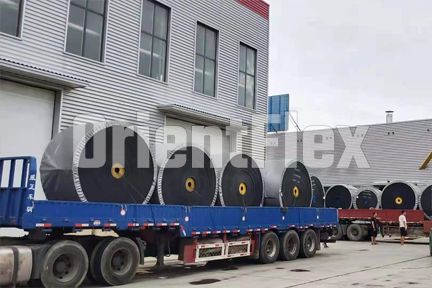- Email orientflex@orientrubber.com
- WhatsApp / Phone+86 180 3186 9514
Belt conveyors are generally composed of rollers and driving, braking, conveying belts, rollers, tensioning, loading, unloading, cleaning and other devices, and have a wide range of applications in the mining industry.
Belt conveyor installation
1. Main body installation sequence
The installation sequence of the main body of the belt conveyor should be to install the headstock first, then the middle frame of each section, and finally install the tailstock. Before installing the frame, the center position of the conveyor should be determined first, and all the working operation centers of the conveyor should be in a straight line. In the process of installing each frame, the longitudinal center position of the conveying distance should be consistent, and the longitudinal horizontal tilt angle must be within the allowable range. The error range of the single-row rack to the center line should be ±0.1mm, and the error of the overall length of the conveyor to the center of the rack should also be less than 35mm. After ensuring that the placement of all single-section racks is correct, all parts can be connected. After the connection is completed, the firmness of the installation and the accuracy of the center position should be checked.
2. Installation of the drive device
Make sure that the drive shaft of the belt conveyor is perpendicular to the center line, and ensure that the center line of the conveyor overlaps with the center of the drive roller width, and the traditional axis and the axis of the reducer should also be parallel. of. The horizontal error range of the shaft should be within the range of 0.5-1.5mm. In the process of installing the drive device, the corresponding tensioning device can also be installed at the same time. The center line of the belt conveyor and the roller axis of the tensioning device should also be It is vertical.
3. Installation of rollers in various parts
This step is a very important part of installing the belt conveyor, and it has an important influence on the working efficiency and service life of the belt conveyor. After installing the frame, the transmission device and the tensioning device one after another, the installation operation of the roller frame and the upper and lower rollers should be carried out. The conveyor belt should gradually assume the shape of a curved arc, and the spacing of the roller racks in the turning section It should be half of the normal roller frame. After the installation is completed, ensure that it has sufficient flexibility and reliability.
4. Debugging after installation
In the process of installing the frame, roller and idler, the following conditions should also be met at the same time:
(1) All the rollers should be kept parallel and arranged in rows with each other;
(2) All the supporting rollers should also be kept horizontal and parallel and arranged in rows with each other;
(3) After the current preparation work is completed, the rack can be installed on the floor or foundation. After the belt conveyor is fixed, the feeding device and the unloading device can be installed;
(4) All supporting structure frames should be kept horizontally parallel and in a straight line. Therefore, when the process of installing the driving roller and the supporting roller frame is completed, the horizontal position and center position of the conveyor should be corrected immediately.
In addition, it is necessary to carry out the operation of the idling test machine in advance to ensure that the conveyor belt does not deviate when it is working. At the same time, the operating law of the idler roller, the contact degree between the surface of the conveyor belt and the guide plate, the operating temperature of the driving part, etc. The parameters also meet the requirements of use, and necessary debugging work must be carried out. Only after all are confirmed to be correct, the operation test can be carried out.
Maintenance of belt conveyor
1. Cleaning
Cleaning is the focus of maintenance work for belt conveyors. Pay attention to cleaning work. Pressure water should not be used to directly wash electrical parts, such as various electrical components, motors, switches, etc., and rollers and bearing seats should also not be directly washed.
The main purpose of cleaning is to ensure personal safety, prevent material spilling, cause the conveyor to block, prevent dust from interfering with the normal operation of electrical appliances, and discover hidden faults in the belt conveyor in time to improve work efficiency.
2. Lubrication
The lubrication of the mechanical parts of the belt conveyor is an important part of its daily maintenance. The lubricating oil film can reduce the wear of the mechanical parts and extend the service life. The frictional heat generated during the operation of the conveyor can also be dissipated through the lubricating oil.
3. Daily inspection
Checking parts and replacing equipment is also the daily work of conveyor maintenance. If the belt conveyor bearing deflects due to external force, we must stop working and check whether the belt conveyor's electrical belt transportation support is stable and whether its debugger is installed in place.
In fact, to truly master the operation mode of the belt conveyor, we have to follow the law of operation of the belt conveyor, especially the staff should be more vigilant, pay attention to the lowest line of defense between man and machine, cannot operate in violation of regulations, and use some advanced The instrument performs the inspection and prevention of belt conveyor failures, thereby reducing the occurrence of accidents.
You can contact or visit us in our office from Monday to Friday from 8:00 - 18:00





